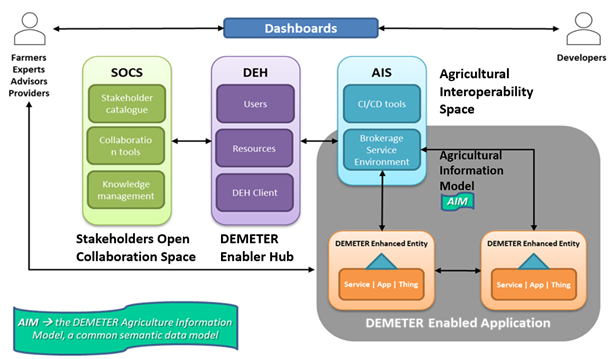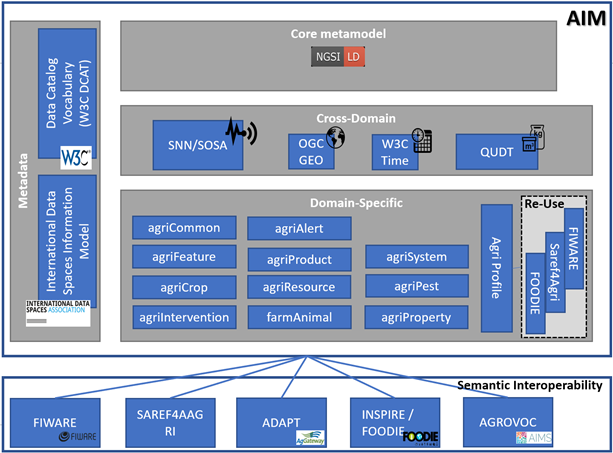
Arne Berre, SINTEF and DEMETER Standardisation Activity Coordinator
One of the key challenges towards the realization of smart farming solutions is related to the lack of interoperability between different systems and platforms in the agri-food sector, especially the ones offered by different technology providers. It is also a concern for farmers that the technology that they invest in will become outdated. DEMETER is addressing these needs for technical and semantical interoperability through the Agricultural Interoperability Space (AIS) and the underlying Agriculture Information Model (AIM). The former offers a wide range of interoperability mechanisms that facilitate the development, validation and deployment of the DEMETER solution, while the latter provides the common (semantic) language used by DEMETER enabled applications to exchange data.

Figure 1 – DEMETER Architecture elements with Agricultural Interoperability Space (AIS) and Information Model (AIM)
The DEMETER Agricultural Interoperability Space (AIS) focuses on delivering a full set of mechanisms and tools intended to support the interoperation, integration, and deployment of solutions. This is supporting both technical and semantical interoperability of different farming systems. DEMETER does not define completely new interoperability mechanisms, but uses (and extends) a wide range of pre-existing tools at device, data, service and application levels. Data in AIS are mainly shared either through the integration with data spaces and other data services or through pub/sub channels. Standardized interfaces and data models are offered to support expandable agriculture applications. AIS supports deployment to cloud, datacenter, hybrid, edge and other environments. The Brokerage Service Environment (BSE) is a central module of the AIS DEMETER architecture, which facilitates the registration, discovery and ultimately communication process for the DEMETER-enabled resources in a secure and privacy preserving manner. In the framework of DEMETER, a resource coupled with the necessary enablers for authentication and authorisation is named a DEMETER enhanced entity (DEE). A DEMETER-enhanced entity will become associated with DEMETER core enablers for functional interoperability and access control and make use of the DEMETER Agricultural Information Model (AIM) in order to support semantic interoperability – so that different systems will be able to understand the meaning of different terms. The creation of DEMETER Enabled Applications is supported tools for Continuous Integration and Deployment (CI/CD). Continuous Integration (CI) is a developer practice to keep a working system by small changes growing the system by integrating frequently on the mainline by means of appropriate tools supporting automation with lots of automated tests.
The DEMETER Stakeholders Open Collaboration Space (SOCS) is focusing on resolving the demands on the farmers side using a structured process that converts an individual need or the most relevant / shared need from a set of needs to a challenge. A challenge is then resolved through a unique co-creation process, in which farmers, service advisors and providers can select, together, the most appropriate set of tools, devices, components, data sources, etc., taking into account the existing ones already deployed at the farmers and the farmer-defined improvement goals.
The DEMETER Enabler HUB (DEH) represents the digital space dedicated to external technology providers and consumers of DEMETER where they are able to create and register their own resources. Users have two roles, and they act as DEMETER Provider and DEMETER Consumer. The DEMETER Enabler HUB (DEH) centralizes the full description of all the components, devices, services, data sources, platforms, etc. that are available for reuse and ready for further deployments.
The DEMETER Dashboard is the entry point to the DEMETER ecosystem for all DEMETER Stakeholders. The Dashboard also offers user friendly interfaces to access, understand and control data related to their own accounts, to perform basic administration tasks over their DEMETER accounts, get an overview about the usage of their business data by external stakeholders, etc.

Figure 2: DEMETER Agricultural Information Model (AIM)
Technical interoperability covers applications and infrastructures used to link computer systems and services. The understanding of the data, relationship between them and capability to process it by organisations is a focus of the semantic interoperability layer. The support for semantic interoperability is provided by use of the DEMETER Agricultural Information Model (AIM). AIM provides the basis to enable a semantic interoperability data space. It defines the data elements in terms of concepts, properties and relationships relevant to agri applications, including the semantics/meaning associated with the information exchanged. AIM has been designed following a layered and modular approach, and is realized as a suite of ontologies implemented in line with best practices, reusing existing standards and well-scoped models as much as possible and establishing alignments between them to enable their interoperability and the integration of existing data. AIM is scalable and can easily be extended in order to address additional needs and incorporate new concepts, maintaining its consistency and compliance. In particular, AIM layers include:
- the meta-model layer defining the building blocks of AIM and enabling the back-and-forth conversion between datasets that are based on the property graph model and linked data datasets
- the cross-domain layer defining relevant concepts and properties that are common across multiple domains, and which enable the interoperability with existing standard models and vocabularies
- the domain layer defining agri-specific concepts and properties covering different aspects of interest of agri applications, and which enables the integration of relevant vocabularies in the sector.
- The pilot-specific layer defining additional concepts and properties that are of specific use for particular applications.
Additionally, AIM defines a metadata model that can be used to describe datasets, services or applications in DEMETER.
The NGSI-LD, a standard of the European Telecommunications Standards Institute (ETSI emerging from FIWARE has been chosen as the core data model in AIM. This decision has been aligned with the same decision in a number of other related projects, such as the recently finished IOF2020 project and also as a part of MIMS – Minimal Interoperability Mechanisms – by OASC. The AIM includes integrated support for a number of cross domain standard ontologies such as the OGC and W3C standard SOSA/SSN, GEO/EO standards from OGC and ISO/TC211, INSPIRE, Time standards from W3C, the QUDT quantity ontology, etc. The Agri domain specific concepts are based on and align with a number of domain specific ontologies and models including SAREF4Agri, FIWARE and INSPIRE/FOODIE, establishing mappings with other relevant ontologies including AGROVOC, ADAPT, etc. Metadata for available data sets and services are described through the W3C DCAT Data Catalog Vocabulary. Finally, it should be highlighted that the data exchange mechanisms employed are being harmonised with the IDS – International Data Spaces Information model and the emerging GAIA-X federated Data infrastructure.


